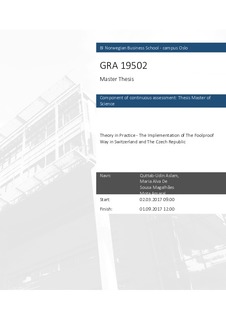| dc.contributor.author | Aslam, Quttab-Udin | |
| dc.contributor.author | Amaral, Maria Alva De Sousa Magalhães Mota | |
| dc.date.accessioned | 2018-02-07T14:16:50Z | |
| dc.date.available | 2018-02-07T14:16:50Z | |
| dc.date.issued | 2017 | |
| dc.identifier.uri | http://hdl.handle.net/11250/2483348 | |
| dc.description | Masteroppgave(MSc) in Master of Science in Business, Economics - Handelshøyskolen BI, 2017 | nb_NO |
| dc.description.abstract | We analyse the similarities between the Svensson’s (2000) “The zero bound in an
open economy: A foolproof way of escaping from a liquidity trap” and the
exchange rate target commitment implemented in Switzerland and the Czech
Republic following the European sovereign debt crisis. We observe that the
foolproof way did not work in Switzerland, mainly due to failure to establish the
peg’s credibility. This is linked to the existence of incomplete pass-through, a
feature not contemplated in Svensson’s model. On the other hand, we conclude
that the foolproof way succeed in the Czech Republic, allowing the economy to
escape the liquidity trap. | nb_NO |
| dc.language.iso | eng | nb_NO |
| dc.publisher | BI Norwegian Business School | nb_NO |
| dc.subject | samfunnsøkonomi | nb_NO |
| dc.subject | economics | nb_NO |
| dc.title | Theory in practice : the implementation of the foolproof way in Switzerland and the Czech Republic | nb_NO |
| dc.type | Master thesis | nb_NO |

